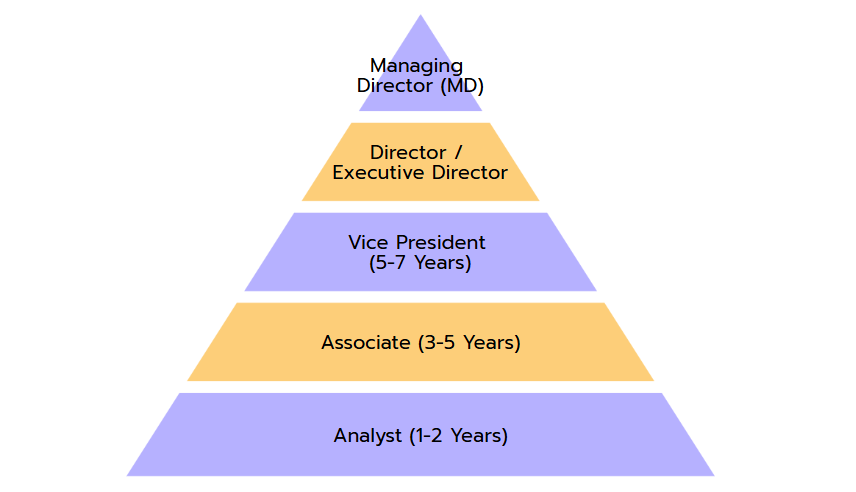Breaking Down the Investment Bank: Who Does What and Why It Matters
An investment bank isn’t just one team doing deals. It’s a layered machine. Some roles are client-facing, while others work behind the scenes. All are essential for keeping the business running. Here’s a breakdown of how it all fits together.

Front Office
This is where the action happens. If you join the Investment Banking Division (IBD), you’ll be advising companies on massive financial decisions such as mergers, acquisitions, IPOs, and restructuring. You’ll work directly with clients and play a key role in shaping strategy and raising capital.
Prefer faster results and a more market-driven vibe? Sales & Trading is all about real-time transactions. You'll help clients buy and sell stocks, bonds, and derivatives, while keeping markets liquid and moving.
Then there’s Research. This team supports both bankers and traders by digging deep into industries and companies. They’re the brains behind the bank’s big ideas.
Middle Office
Supporting the front office is the middle office, where key operational functions take place. Risk Management keeps the bank safe by spotting and controlling exposure to credit, market, or operational risks. Compliance makes sure everything you do follows the rules (no small task in the post-2008 world). Treasury manages the bank’s capital, balance sheet, and overall liquidity-basically, keeping the whole machine running smoothly.
Back Office
You won’t see this side of the bank in headlines, but it’s essential. Operations handles trade settlements, accounting, and all the behind-the-scenes work that keeps deals flowing. Meanwhile, Technology is growing fast-building the systems that power everything from trading platforms to risk models. As finance gets more digital, tech is becoming a bigger part of the story.
Your Best Entry Points into Investment Banking
So, where should you aim to start?
Most students set their sights on the Investment Banking Division (IBD) for good reason. It’s where you’ll get deep into deals, build financial models, and gain exposure to clients and senior bankers early. The learning curve is steep, but the payoff is huge: IBD experience is one of the best launchpads in all of finance, opening doors to private equity, venture capital, and hedge funds.
Prefer faster feedback and real-time market action?
Sales & Trading might be more your speed. You'll work in a high-energy environment, helping clients analyze real-time data and execute trades. It’s perfect if you like the adrenaline of live decision-making.
Both paths offer great training and strong compensation. But if you’re chasing prestige, skill development, and exit flexibility, IBD tends to come out on top.
Investment Banking Career Progression Timeline: From Analyst to Managing Director
Here’s what your career path could look like if you perform well and stick with it.

Analyst (1-2 Years)
You’ll start as an analyst, and yes, this is when the intensity picks up. Expect to build complex models, value companies, create pitch books, and analyze financial and industry data. Deadlines are tight, hours are long (think 80–100 per week), and the learning curve is steep. But this is where you build the core skills that define your career.
Associate (3-5 Years)
Once promoted, things shift. As an associate, you’ll manage analysts, lead parts of client projects, and start owning communications. You’ll still work hard, but your time becomes more structured, and your voice starts to matter more in meetings.
Vice President (5-7 Years)
At VP level, you’re running deals. You’ll spend more time pitching clients, negotiating terms, and making travel your new normal. You’re also responsible for keeping projects on track and mentoring associates.
Director / Executive Director
Here, it’s all about relationships. You’ll focus on winning new business, deepening client connections, and spotting big-picture opportunities that others miss.
Managing Director (MD)
This is the top. As an MD, you're responsible for bringing in millions in revenue, guiding strategy, and leading the firm’s most valuable relationships. It’s a high-pressure role, but compensation can easily hit-or exceed-the seven-figure mark. Every deal you close, every client you win, makes a direct impact.
Investment Banking Salary Guide 2025: Realistic Pay by Role and Region
Let’s talk numbers, because yes, investment banking still pays big.
As a first-year analyst in the U.S., you’ll likely earn between $160,000 and $210,000 total, depending on your bank and bonus. Some firms even throw in a signing bonus just to lock you in.
Move up to associate, and your comp can jump north of $450,000. Vice presidents often break the $500K mark. Directors can make anywhere from $600,000 to $1 million. And managing directors? That’s where the real money kicks in: think seven figures, often tied directly to the revenue you bring in.
However, pay does vary by region. New York leads in base salaries. The UK is setting records with uncapped bonuses. And while Hong Kong and Singapore don’t always match Wall Street, their compensation is still strong, especially compared to regional averages.
Bottom line: the higher you go, the more performance and relationships drive your paycheck.
👉 Find out more about how much you can earn in out article about Investment Banking Salaries Worldwide.
Top Exit Opportunities After Investment Banking: Where Your Career Can Go Next
Not planning to stay in banking forever? You’re not alone. And that’s part of the appeal.
Most analysts spend two or three years in investment banking, then move on to something new. The most popular path? Private equity. It’s fast-paced, high-paying, and starts recruiting nearly a year in advance. If you’ve got solid deal experience and technical skills, you’ll be in demand.
Hedge funds and asset managers are also top destinations, especially if you’ve been in M&A or capital markets. They love bankers who can value companies under pressure and think in terms of market moves. Just be ready for some income volatility; bonuses can swing hard in either direction.
Venture capital is a great fit if you’ve built sector expertise in tech, healthcare, or consumer brands. You’ll help build early-stage companies, but significant earnings typically don’t arrive until you reach the partner level.
Corporate development gives you the best of both worlds: deal exposure and a more manageable 50–60-hour week. You’ll work in-house at a major company, often in strategy or M&A.
Want to pivot entirely or level up? Many bankers go for an MBA to expand their network, shift industries, or set themselves up for senior roles. And of course, a few take the leap into startups, using their modeling skills and network of investors to build something of their own.
How to Break Into Investment Banking: A Year-by-Year Student Roadmap
Wondering how to break into investment banking? Here’s your step-by-step roadmap.
Freshman Year:
Start early. Join a finance or investing club, get comfortable with Excel, and make it a habit to read market news daily. You’re laying the foundation now. Fluency builds over time.
Sophomore Year:
This is when you start leveling up. Take accounting and valuation courses, and try to land a finance-related internship. Even if it’s at a smaller firm, it shows commitment, and gives you stories to tell in interviews.
Junior Year:
This is the big one. Summer analyst applications open fast and early, often before classes even start. Sharpen your technical skills, practice interviews, and network like it’s your job (because soon, it will be). Strong grades and referrals can make all the difference.
Senior Year:
If you landed a junior internship, now’s the time to convert it into a full-time offer. Didn’t get one? Don’t panic. Boutique banks, corporate finance teams, and smaller advisory firms are still hiring. Focus on what you’ve learned and how you add value.
Non-target school?
It’s a tougher path, but not impossible. Double down on academics, gain internship experience, and lean into leadership roles. And remember, an MBA can be a powerful reset button if you need a second shot later on.
Investment Banking Interview Prep: Essential Tips to Land the Offer
Interviews are where great candidates stand out, and unprepared ones get filtered out fast. Here’s what you need to nail it.
Master the technical skills thoroughly.
You’ll be expected to walk through a discounted cash flow (DCF), build a leveraged buyout (LBO) model, and explain accretion/dilution in an M&A scenario. No shortcuts here. You also need to understand how the three financial statements connect, and how changes in one flow through the others.
👉 In our Case Library, you'll find sample questions and practice cases to help you prepare at your best!
Practice, then practice some more.
Mock interviews are your best friend. Go through technical and behavioral questions with a peer, mentor, or even in front of a mirror. And when you’re telling stories, use the STAR method (Situation–Task–Action–Result). It keeps your answers clear and focused.
👉 Use our Meeting Board to connect with like-minded peers and schedule practice sessions!
Polish your resume until it shines.
Use numbers to back up every bullet. Highlight leadership, problem-solving, and analytical wins. Stick to clean formatting. Banks want clarity, not creativity.
Bonus points:
Have a sharp LinkedIn profile, a personal story that shows why banking fits you, and a track record of following finance news and trends. It all adds up to a candidate who’s serious, prepared, and easy to picture on the team.
The Reality of Work-Life Balance in Investment Banking: Can You Handle It?"
Let’s be real: banking is intense.
As an analyst, you’ll likely clock 80 to 100 hours a week. That means late nights, weekends, and canceled plans (especially when deals are live). when deals are live. The pressure’s real, and so is the burnout risk if you don’t manage it.
That said, things are improving. Many banks now offer protected weekends, required vacation time, and access to mental health support. Some even use tech to automate routine work; though when a big deal drops on Friday night, no tool can save you.
The best bankers learn to protect their energy. They prioritize sleep, exercise, relationships, and efficient workflows. These small habits things that make a big difference over time. It’s not about achieving perfect balance. It’s about staying in the game, staying sharp, and knowing when to step back so you can keep performing at a high level.
👉 Get more insights in out article about Work-Life Balance in Investment Banking.
Key Takeaways
If you’re aiming for investment banking in 2025, know this: it’s not easy. But for many, it can be well worth the effort.
You’ll sacrifice time, energy, and sleep. But in return, you’ll get world-class training, valuvable experience, and strong credentials that open doors across the finance industry. The challenge is real. So is the payoff.
So what should you do right now?
Start building your technical skills. Connect with alumni. Stay on top of market trends. Join finance clubs, take leadership roles, and stack your resume with real wins. Prep early. Network often. Practice hard.
Break in and you won’t just land a job. You’ll earn a spot in one of the most competitive, rewarding fields out there.





